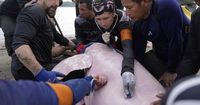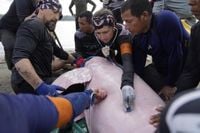In the heart of Colombia’s Amazon, a flash of pink breaks the muddy river surface—a fleeting glimpse of the endangered pink river dolphin, or Inia geoffrensis. For scientists and veterinarians wading waist-deep in the warm current near Puerto Nariño, this isn’t just a rare sighting; it’s the start of a painstaking operation to monitor the health of a species under siege from a silent, invisible enemy: mercury contamination.
On September 16, 2025, as reported by The Associated Press, a dedicated team set out with mesh nets, experienced fishermen, and local experts to capture and test these elusive creatures. Their goal? To assess the levels of mercury—mainly from illegal gold mining and deforestation—coursing through the Amazon’s most graceful predators. The stakes couldn’t be higher, both for the dolphins and for the river’s broader ecosystem.
The entire operation is a race against the clock. Once a dolphin is brought aboard—a process that can end with a stinging blow as the animal thrashes to break free—the team has just 15 minutes to complete a battery of medical tests before returning it to the water. One person counts the dolphin’s breaths, another wets its skin to keep it cool, while the rest draw blood and tissue samples. A portable ultrasound scans lungs, heart, and other vital organs for signs of disease. The team photographs scars, swabs blowholes and genital openings for bacterial cultures, and implants microchips to track individuals and prevent duplicate testing.
Fernando Trujillo, a marine biologist who leads the effort and heads the Omacha Foundation, kneels beside each dolphin’s head, shielding its eye with a cloth and speaking in low tones. “They’ve never felt the palm of a hand. We try to calm them,” Trujillo told AP, adding, “Taking a dolphin out of the water, it’s a kind of abduction.”
Trujillo’s team isn’t just collecting data—they’re using dolphins as sentinels for the river’s health. “We take blood and tissue samples to assess mercury,” he explained. “Basically, we’re using dolphins as sentinels for the river’s health.” The mercury threat is not new, but it’s growing. Illegal gold miners use mercury to separate gold from sediment, then dump the sludge back into rivers, where it enters the food chain—first fish, then people and dolphins. Deforestation compounds the problem, washing naturally occurring mercury from soil into waterways.
The numbers are alarming. “The maximum any living being should have is 1 milligram per kilogram,” Trujillo said. “Here, we’re seeing 20 to 30 times that amount.” In previous years, his team found up to 18 milligrams per kilogram of mercury in dolphins. In Colombia’s Orinoco River, some dolphins have tested as high as 42 milligrams per kilogram—levels among the most extreme ever recorded for the species. Mercury poisoning can cause neurological damage, organ failure, and immune system breakdown in dolphins, just as it does in humans. The World Health Organization and the U.S. Environmental Protection Agency warn that pregnant women and children are especially vulnerable, with prenatal exposure linked to developmental delays and reduced cognitive function.
Trujillo’s own experience underscores the risk. Three years ago, after decades working in mercury-affected areas and eating a fish-heavy diet, his blood mercury levels were 36.4 milligrams per kilogram—over 36 times the recommended limit. With medical help, he’s managed to reduce that to about 7 milligrams. “Mercury is an invisible enemy until it builds up to a sufficient amount, then it starts to affect the central nervous system,” Trujillo said after his team tested four pink dolphins in a single morning. “We’re already seeing evidence of it in Indigenous communities.”
The impact on people living along the Amazon is deeply troubling. Studies by the International Pollutants Elimination Network and academic researchers have found high mercury exposure among Indigenous populations in Brazil, Peru, Colombia, Suriname, and Bolivia. Hair samples often show levels well above the World Health Organization’s safe threshold of 1 part per million. In one Colombian community, hair mercury reached more than 22 milligrams per kilogram.
The dolphins themselves are in crisis. Trujillo’s monitoring shows a 52% decline in pink river dolphins and a 34% drop in gray river dolphins over recent decades. The International Union for Conservation of Nature listed the pink river dolphin as endangered in 2018. While exact numbers across the Amazon are elusive, Trujillo’s organization estimates there are between 30,000 and 45,000 left. But the threats keep mounting: overfishing, accidental entanglement in fishing nets, boat traffic, habitat loss, and prolonged drought all take their toll.
Colombia has taken steps to address the crisis. The government banned mercury use in mining in 2018, ratified the Minamata Convention to reduce mercury in the environment, and submitted an action plan in 2024. Authorities point to joint operations with Brazil and recent enforcement sweeps, but watchdog groups say illegal mining remains widespread. Other Amazon nations are also stepping up. Brazil has launched raids and restricted satellite internet used by illegal gold-mining camps to disrupt logistics. Peru recently seized a record four tons of smuggled mercury. Ecuador, Suriname, and Guyana have filed action plans to reduce mercury use in small-scale gold mining.
The dolphin testing operation itself is a marvel of coordination and determination. José “Mariano” Rangel, a former fisherman from Venezuela, leads the charge when it’s time to haul the animals—some weighing up to 160 kilograms (about 353 pounds)—into small boats. “The most difficult part of the captures is enclosing the dolphins,” Rangel said. The team’s work doesn’t end on the riverbank. After a long morning, they return to a laboratory in Puerto Nariño, surrounded by posters of dolphins and manatees and the bones and skulls of past specimens. There, they analyze samples, prepare others for larger facilities, and repair nets for the next day’s work.
The Omacha Foundation’s research has already revealed worrying trends beyond mercury poisoning. The team has documented antimicrobial resistance—bacteria that can’t be killed by common medicines—and respiratory problems in dolphins. They’ve also identified possible emerging diseases, such as papilloma virus, that could pose risks to both dolphins and humans.
For Trujillo and his colleagues, every capture, scan, and blood test is part of a larger battle for the Amazon’s future. “We are one step away from being critically endangered and then extinct,” Trujillo warned. The fate of the pink river dolphin is intertwined with the health of the river and the people who depend on it. As the Amazon faces mounting threats from illegal mining, deforestation, and climate change, the work of these scientists stands as both a warning and a call to action.


